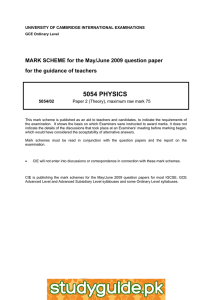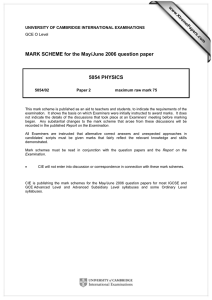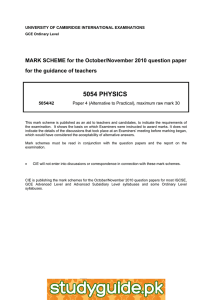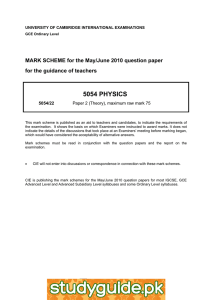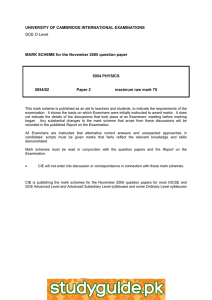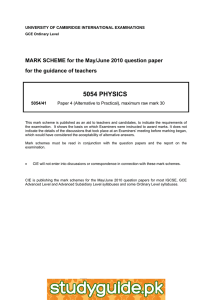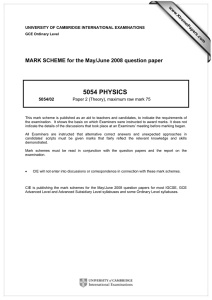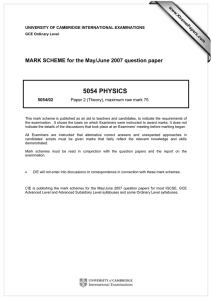5054 PHYSICS MARK SCHEME for the May/June 2009 question paper
advertisement
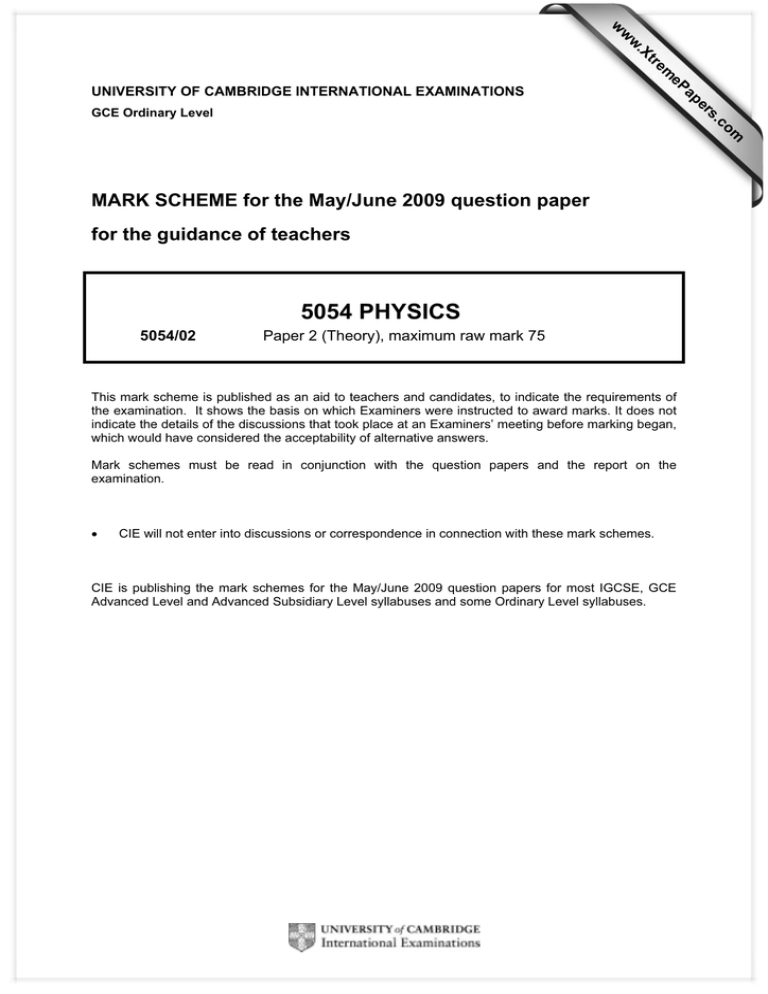
w w ap eP m e tr .X w UNIVERSITY OF CAMBRIDGE INTERNATIONAL EXAMINATIONS s er om .c GCE Ordinary Level MARK SCHEME for the May/June 2009 question paper for the guidance of teachers 5054 PHYSICS 5054/02 Paper 2 (Theory), maximum raw mark 75 This mark scheme is published as an aid to teachers and candidates, to indicate the requirements of the examination. It shows the basis on which Examiners were instructed to award marks. It does not indicate the details of the discussions that took place at an Examiners’ meeting before marking began, which would have considered the acceptability of alternative answers. Mark schemes must be read in conjunction with the question papers and the report on the examination. • CIE will not enter into discussions or correspondence in connection with these mark schemes. CIE is publishing the mark schemes for the May/June 2009 question papers for most IGCSE, GCE Advanced Level and Advanced Subsidiary Level syllabuses and some Ordinary Level syllabuses. Page 2 Mark Scheme: Teachers’ version GCE O LEVEL – May/June 2009 Syllabus 5054 Paper 02 1 unit penalty per question. Allow 2 or more sig. figs throughout paper. 2 or 3 sig. fig. answers must be correctly rounded. Section A 1 2 (a) (speed) increases or (paper) accelerates (speed) becomes constant/uniform or acceleration zero (after 0.5 s) B1 B1 (b) any clear change in distance/time or 1.87 (m/s) (allow 1.9) 2.3–2.5 m/s C1 A1 (c) PE at beginning of a change heat/internal energy/thermal energy at end of a change/K.E. of air B1 B1 (a) (i) conduction B1 (ii) molecules hit each other or molecules pass vibration on or free electrons move (through metal) and hit molecules (b) (i) downwards at or near X 4 B1 B1 (ii) hot water less dense or cold water more dense hot water rises (not heat rises) or cold water falls convection current mentioned or water flows to replace hot water that rises or rising and falling described or water cools at surface 3 [6] B1 B1 B1 (a) (E =) P.t in any algebraic form or 85 × 120 or 85 × 2 or 170 10200 J or 2.8 × 10–3 kW h C1 A1 (b) (H =) mL seen in any algebraic form or (a)/31 or (a)/0.031 330 or 329 J/g or 3.29 × 105 J/kg ecf (a) C1 A1 (c) heat/time needed to warm ice to 0°C/melting point/freezing point B1 (a) solid more regular/ordered etc. or less space/separation between molecules or vv or solid molecules fixed and liquid molecules move throughout B1 (b) (i) solids: strong(er) forces/bonds or energy not enough to break molecules free or vv B1 (ii) fast(er)/high(er kinetic) energy molecules escape/evaporate molecules left are slower/less kinetic energy (on average) B1 B1 (iii) (hotter) molecules move faster/higher energy more molecules have energy/speed to break bonds/overcome forces B1 B1 © UCLES 2009 [6] [5] [6] Page 3 5 6 7 Mark Scheme: Teachers’ version GCE O LEVEL – May/June 2009 (a) (i) correct ray Paper 02 B1 (ii) correct angle marked to normal B1 (iii) (the angle) between the incident ray and the normal (at the point of contact) B1 (b) correct ray from hat to eye 0.85–1.15 m B1 B1 (a) (sound) too high a frequency to be heard or (frequency) above 20 kHz B1 (b) (f =) v/λ or v = f λ algebraic or numerical 1 250 000 Hz C1 A1 (c) vibrate/oscillate vibration etc. in same direction as/parallel to wave/energy or horizontally C1 A1 (d) pressure increases and decreases or compressions and rarefactions mentioned in (d) or particles come together and move apart B1 (a) NS marked on each piece correctly B1 (b) NS/unlike/opposite poles attract switch closes or soft-iron/contacts touch B1 B1 (c) (i) resistance decreases B1 (ii) current increases clearly in coil/through thermistor magnetic field (in coil) (and contacts close) 8 Syllabus 5054 B1 B1 (a) number of protons and neutrons protons and neutrons in the nucleus B1 B1 (b) (i) 2 B1 (ii) 4 B1 (iii) 90 or 92–(i) and (iv) 234 or 238–(ii) B1 © UCLES 2009 [5] [6] [6] [5] Page 4 Mark Scheme: Teachers’ version GCE O LEVEL – May/June 2009 Syllabus 5054 Paper 02 Section B 9 (a) circuit diagram showing power supply, lamp and ammeter in series voltmeter across lamp ensure voltage is 24 V in some way e.g. power supply 24 V V × I or voltmeter × ammeter readings B1 B1 B1 B1 (b) (i) P 0.63(2) A Q 1.26(3) A R 1.89(5), 1.9 A or sum of candidate’s P and Q B1 B1 B1 (ii) 240/current at R or 1/R = 1/R1 + 1/R2 127, 130, 126.7 Ω ecf (i) (c) (i) (I =) V/R numerical or algebraic 0.42 A (ii) 80 V or 79.8 V ecf (i) C1 A1 C1 A1 B1 (d) one lamp goes out/blows/fuses/switched off they do not all go out/others stay on lamps are working at correct/more brightness/voltage/current power reference to voltage is 240 V across each lamp or voltage shared in series/<240 V or current value(s) quoted 10 (a) (i) air resistance increases (as speed increases) (at constant speed) becomes equal to driving force/applied force etc. (ii) driving force (forward force) larger (than air resistance/backwards force) (b) (i) (E =) ½ mv2 algebraic formula ½ × 75 × 42 600 J B1 B1 B1 [15] B1 B1 B1 C1 C1 A1 (ii) (a =) F/m algebraic seen or 10 (N) used as force 0.13 m/s2 (c) (i) friction (in chain/axles) or rubbing of surfaces heat or thermal energy produced (ii) (efficiency = useful) energy output/energy input algebraic or numerical or 380 seen 0.95 or 95% © UCLES 2009 C1 A1 B1 B1 C1 A1 Page 5 Mark Scheme: Teachers’ version GCE O LEVEL – May/June 2009 (d) lower mass/weight of cycle less force needed greater acceleration/easier to acc. less energy/work (input) less kinetic energy more efficient/less energy wasted less friction less pressure (on ground) Syllabus 5054 Paper 02 B1 same acceleration/get up hill/to stop cycle/lift cycle for same force or F = ma quoted to go uphill/due to less friction/½ mv2 less less stopping distance/less force to stop going uphill/less friction easier turn handlebars/higher (top) speed sinks less into ground M1A1 [15] 11 (a) (i) coil and magnet (poles) in a correct orientation – no label needed 2 slip rings correct and labelled brushes touching 2 slip rings, labelled (ii) induction of voltage or current (magnetic) flux change or field/flux lines cut wire/coil (b) (i) attach (generator to) voltmeter measure voltage (e.g. gives 1.0 V, ±0.5 V) measure trace height (e.g. gives 0.5 div, ±0.25 div) clear 2 V moves up 1 div OR observe trace/line/spot with no input apply battery/voltage (to y input) measure voltage applied (with voltmeter) or battery has known voltage check distance moved up/down for voltage supplied e.g. 2 V moves up 1 div (ii) volts/div (vertically) changed (e.g. 2 V/div decreased, changes to 0.2 V/div) or y-gain changed to expand trace vertically time/div (horizontally) changed or time base/x-gain changed to expand trace horizontally y-shift used to move trace up B1 B1 B1 B1 B1 B1 B1 B1 B1 B1 B1 B1 B1 B1 B1 B1 (if no mark – y gain and time base/x gain mentioned B1 trace expanded vertically and horizontally B1) (iii) hot/heated filament/cathode or by thermionic emission anode electrons attracted by/accelerated towards positive voltage/anode B1 B1 B1 [15] MARK SCHEME CODE B1 C1 M1 A1 e.c.f. vv Independent mark. Compensation mark; given automatically if the answer is correct, i.e. the working need not be seen if the answer is correct; also given if the answer is wrong but the point is seen in the working. Method mark: if not given subsequent A marks fall (up to next B, M or C mark). Answer mark. error carried forward; it usually is even where not specifically indicated, i.e. subsequent working including a previous error is credited, if otherwise correct. vice versa © UCLES 2009
